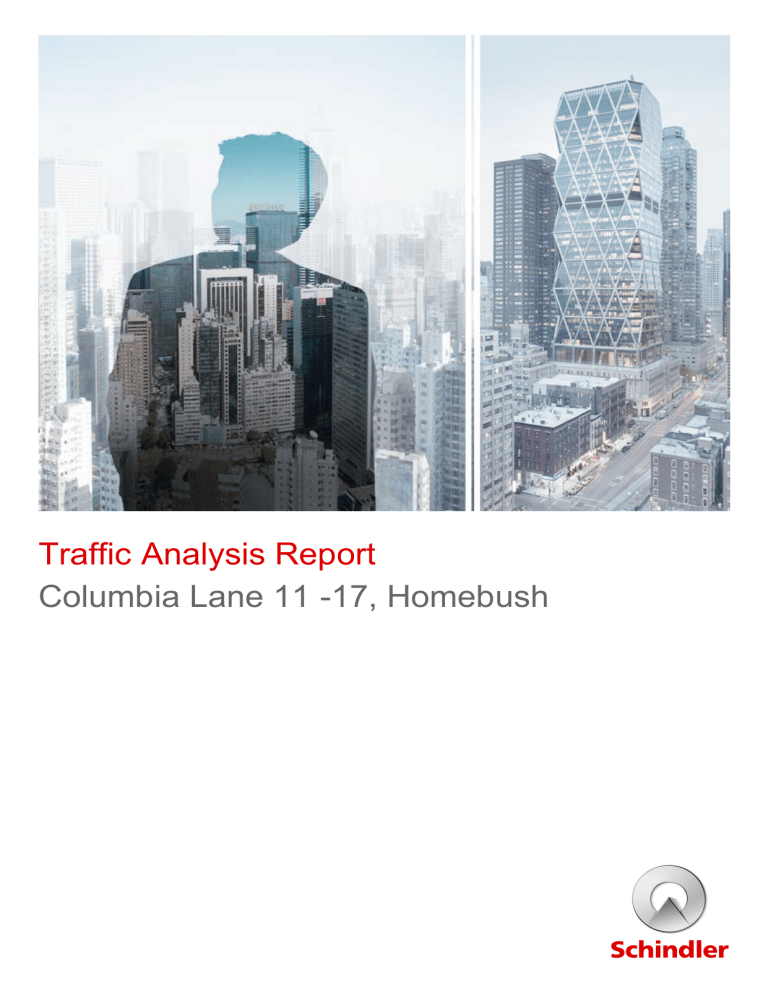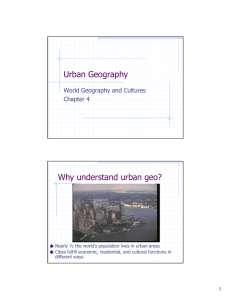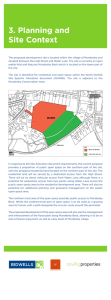DA2019.143 (Revised) - Lift Operation Traffic Analysis Report - 11-17 Columbia Lane, Homebush
advertisement

Traffic Analysis Report Columbia Lane 11 -17, Homebush 1 2 3 Summary Standards and Recommendations Details 5 6 8 9 4 3.1 3.2 3.3 3.4 Building A - 2 lifts Building A - 3 lifts Building B - 2 lifts Building B - 3 lifts _____________ 5 _____________ 9 ____________ 13 ____________ 17 How Schindler Undertakes Traffic Analyses 4.1 Introduction _________________ 21 4.2 Measures and Definitions ______ 21 4.3 Methods of Traffic Analysis _____ 23 7 0 1 July 2020 This traffic analysis has been prepared by:Manuel Dias Sales Manager - New Instalations and Modernisations manuel.dias@au.schindler.com 0413 801 626 Schindler Lifts Australia Pty Ltd Building D, Sir Joseph Banks Corporate Park 36 - 38 Lord Street, Botany, NSW, 2019 This document has 23 pages. www.au.schindler.com Copyright INVENTIO AG, Hergiswil, Switzerland Created by Traffic Vision 3.0 (Schindler IX Version 1.20.2.0) Columbia Lane 11 -17, Homebush 2 1 2 3 4 5 6 7 8 9 0 Summary Summary Legend Setup Traffic Situation: Floors: Population: Rating: See Section 2 Floors served by lifts Population served by lifts See Section 2 Abbreviations P5: Persons transported on average within 5 minutes HC5: P5 relative to group population WT: Average waiting time per passenger DT: Average destination time per passenger IS: Average number of intermediate stops per passenger LW: Passengers waiting more than 90 seconds [%] 1 Building A - 2 lifts Lifts: 2 Conventional, 1350 kg, 2.50 m/s Traffic Situation Two-Way Residential Floors -3..-2, 0..24 Population Rating 449 3.8 P5 27 HC5 6.0 % WT 51.6 s DT 98.9 s IS LW 1.8 16.5 % Population Rating 449 4.9 P5 31 HC5 7.0 % WT 35.5 s DT 81.1 s IS LW 1.3 6.2 % Population Rating 488 3.3 P5 29 HC5 6.0 % WT DT 68.2 s 125.0 s IS LW 2.5 29.3 % Population Rating 488 4.4 P5 34 HC5 7.0 % WT DT 47.3 s 101.3 s IS LW 1.8 13.1 % 2 Building A - 3 lifts Lifts: 3 Conventional, 1350 kg, 2.00 m/s Traffic Situation Two-Way Residential Floors -3..-2, 0..24 3 Building B - 2 lifts Lifts: 2 Conventional, 1350 kg, 2.50 m/s Traffic Situation Two-Way Residential Floors -4..-2, 0..24 4 Building B - 3 lifts Lifts: 3 Conventional, 1350 kg, 2.00 m/s Traffic Situation Two-Way Residential Floors -4..-2, 0..24 Columbia Lane 11 -17, Homebush 3 1 2 3 4 5 6 7 8 9 0 Standards and Recommendations Standards and Recommendations Every analysis covers a full range of traffic intensities, reporting handling capacity HC5 and average waiting time WT as main criteria. As a general guideline, Schindler defines a rating in the range of 0.0 (worst) to 6.0 (best) based on these criteria. Recommended ratings are 3.0 or higher: Schindler Traffic Analysis Ratings Traffic Situation Two-Way Residential Traffic Definition Incoming Outgoing Inter-floor 50 % 50 % 0% Rating ≥ 3.0 HC5 WT ≥6% ≤ 80 s Rating ≥ 4.0 HC5 WT ≥7% ≤ 60 s Rating ≥ 5.0 HC5 WT ≥8% ≤ 40 s Ratings are also displayed by a corresponding number of stars and may be interpreted on a global basis as follows: Rating ≥ 3.0 ≥ 4.0 ≥ 5.0 Stars Residential Basic segment Medium segment Premium segment Columbia Lane 11 -17, Homebush 4 1 2 3 4 5 6 7 8 9 0 Details Building A - 2 lifts Building and Population Details 3.1 Building A - 2 lifts 3.1.1 Building and Population Number of Floors: 28 Building Population: 449 Columbia Lane 11 -17, Homebush 5 1 2 3 4 5 6 7 8 9 0 Details Building A - 2 lifts Lifts 3.1.2 Lifts Control: Conventional Columbia Lane 11 -17, Homebush 6 1 2 3 4 5 6 7 8 9 0 Details Building A - 2 lifts Two-Way Residential 3.1.3 Two-Way Residential 3.1.3.1 Traffic Definition Population served by lifts: 449 Passenger Flows Floor 24 23 22 21 20 19 18 17 16 15 14 13 12 11 10 9 8 7 6 5 4 3 2 1 0 -1 -2 -3 Description Residential Residential Residential Residential Residential Residential Residential Residential Residential Residential Residential Residential Residential Residential Residential Residential Residential Residential Residential Residential Residential Residential Residential Residential Lobby Parking Parking Parking Incoming 50 % 2.7 % 2.7 % 2.7 % 4.0 % 4.0 % 4.0 % 4.0 % 4.0 % 4.0 % 4.0 % 4.0 % 4.0 % 4.0 % 4.0 % 4.0 % 4.0 % 3.7 % 5.0 % 5.4 % 5.4 % 5.4 % 5.4 % 5.4 % 4.3 % 85.3 % 6.7 % 8.0 % Outgoing 50 % 2.7 % 2.7 % 2.7 % 4.0 % 4.0 % 4.0 % 4.0 % 4.0 % 4.0 % 4.0 % 4.0 % 4.0 % 4.0 % 4.0 % 4.0 % 4.0 % 3.7 % 5.0 % 5.4 % 5.4 % 5.4 % 5.4 % 5.4 % 4.3 % 85.3 % 6.7 % 8.0 % Columbia Lane 11 -17, Homebush 7 1 2 3 4 5 6 7 8 9 0 Details Building A - 2 lifts Two-Way Residential 3.1.3.2 Performance Average Waiting Time (WT) Average Destination Time (DT) Average Number of Intermediate Stops per Passenger (IS) Long Waits (LW) HC5 [%] P5 WT [s] DT [s] IS LW [%] 5.0 22.4 41.8 82.6 1.2 9.4 1.0 4.5 10.9 37.1 0.1 0.0 2.0 9.0 16.6 44.6 0.2 0.2 3.0 13.5 23.7 54.7 0.4 1.2 4.0 17.9 32.2 67.4 0.8 4.1 6.0 26.9 51.6 98.9 1.8 16.5 7.0 31.4 63.8 118.8 2.4 26.2 8.0 35.9 78.7 142.5 3.1 36.7 Columbia Lane 11 -17, Homebush 8.5 38.2 87.8 155.7 3.4 42.5 8 1 2 3 4 5 6 7 8 9 0 Details Building A - 3 lifts Building and Population 3.2 Building A - 3 lifts 3.2.1 Building and Population Number of Floors: 28 Building Population: 449 Columbia Lane 11 -17, Homebush 9 1 2 3 4 5 6 7 8 9 0 Details Building A - 3 lifts Lifts 3.2.2 Lifts Control: Conventional Columbia Lane 11 -17, Homebush 10 1 2 3 4 5 6 7 8 9 0 Details Building A - 3 lifts Two-Way Residential 3.2.3 Two-Way Residential 3.2.3.1 Traffic Definition Population served by lifts: 449 Passenger Flows Floor 24 23 22 21 20 19 18 17 16 15 14 13 12 11 10 9 8 7 6 5 4 3 2 1 0 -1 -2 -3 Description Residential Residential Residential Residential Residential Residential Residential Residential Residential Residential Residential Residential Residential Residential Residential Residential Residential Residential Residential Residential Residential Residential Residential Residential Lobby Parking Parking Parking Incoming 50 % 2.7 % 2.7 % 2.7 % 4.0 % 4.0 % 4.0 % 4.0 % 4.0 % 4.0 % 4.0 % 4.0 % 4.0 % 4.0 % 4.0 % 4.0 % 4.0 % 3.7 % 5.0 % 5.4 % 5.4 % 5.4 % 5.4 % 5.4 % 4.3 % 85.3 % 6.7 % 8.0 % Outgoing 50 % 2.7 % 2.7 % 2.7 % 4.0 % 4.0 % 4.0 % 4.0 % 4.0 % 4.0 % 4.0 % 4.0 % 4.0 % 4.0 % 4.0 % 4.0 % 4.0 % 3.7 % 5.0 % 5.4 % 5.4 % 5.4 % 5.4 % 5.4 % 4.3 % 85.3 % 6.7 % 8.0 % Columbia Lane 11 -17, Homebush 11 1 2 3 4 5 6 7 8 9 0 Details Building A - 3 lifts Two-Way Residential 3.2.3.2 Performance Average Waiting Time (WT) Average Destination Time (DT) Average Number of Intermediate Stops per Passenger (IS) Long Waits (LW) HC5 [%] P5 WT [s] DT [s] IS LW [%] 1.0 4.5 8.1 38.3 0.0 0.0 2.0 9.0 10.9 41.8 0.1 0.1 3.0 13.5 14.4 47.0 0.2 0.2 4.0 17.9 18.8 53.7 0.4 0.6 5.0 22.4 24.2 61.9 0.6 1.6 6.0 26.9 29.8 71.1 0.9 3.4 7.0 31.4 35.5 81.1 1.3 6.2 8.0 35.9 42.1 93.1 1.7 9.7 9.0 40.4 48.7 105.7 2.1 14.3 10.0 44.9 55.5 117.7 2.5 19.9 11.0 49.3 63.9 131.7 2.9 26.3 Columbia Lane 11 -17, Homebush 12.0 53.8 76.4 149.6 3.3 34.7 13.1 58.7 88.7 166.5 3.7 44.0 12 1 2 3 4 5 6 7 8 9 0 Details Building B - 2 lifts Building and Population 3.3 Building B - 2 lifts 3.3.1 Building and Population Number of Floors: 29 Building Population: 488 Columbia Lane 11 -17, Homebush 13 1 2 3 4 5 6 7 8 9 0 Details Building B - 2 lifts Lifts 3.3.2 Lifts Control: Conventional Columbia Lane 11 -17, Homebush 14 1 2 3 4 5 6 7 8 9 0 Details Building B - 2 lifts Two-Way Residential 3.3.3 Two-Way Residential 3.3.3.1 Traffic Definition Population served by lifts: 488 Passenger Flows Floor 24 23 22 21 20 19 18 17 16 15 14 13 12 11 10 9 8 7 6 5 4 3 2 1 0 -1 -2 -3 -4 Description Residential Residential Residential Residential Residential Residential Residential Residential Residential Residential Residential Residential Residential Residential Residential Residential Residential Residential Residential Residential Residential Residential Residential Residential Lobby Parking Parking Parking Parking Incoming 50 % 5.2 % 3.7 % 3.7 % 3.7 % 3.7 % 3.7 % 3.7 % 3.7 % 4.0 % 4.0 % 4.0 % 4.0 % 4.0 % 4.0 % 4.0 % 4.0 % 3.7 % 4.9 % 4.9 % 4.9 % 4.9 % 4.9 % 4.9 % 3.7 % 77.5 % 6.2 % 7.4 % 9.0 % Outgoing 50 % 5.2 % 3.7 % 3.7 % 3.7 % 3.7 % 3.7 % 3.7 % 3.7 % 4.0 % 4.0 % 4.0 % 4.0 % 4.0 % 4.0 % 4.0 % 4.0 % 3.7 % 4.9 % 4.9 % 4.9 % 4.9 % 4.9 % 4.9 % 3.7 % 77.5 % 6.2 % 7.4 % 9.0 % Columbia Lane 11 -17, Homebush 15 1 2 3 4 5 6 7 8 9 0 Details Building B - 2 lifts Two-Way Residential 3.3.3.2 Performance Average Waiting Time (WT) Average Destination Time (DT) Average Number of Intermediate Stops per Passenger (IS) Long Waits (LW) HC5 [%] P5 WT [s] DT [s] IS LW [%] 1.0 4.9 12.5 40.3 0.1 0.1 2.0 9.8 20.1 50.2 0.3 0.6 3.0 14.6 29.6 63.9 0.6 3.2 4.0 19.5 41.5 81.6 1.1 9.0 5.0 24.4 54.0 101.5 1.7 18.5 6.0 29.3 68.2 125.0 2.5 29.3 7.0 34.1 85.1 151.7 3.2 40.9 7.3 35.8 92.1 162.0 3.5 45.7 Columbia Lane 11 -17, Homebush 16 1 2 3 4 5 6 7 8 9 0 Details Building B - 3 lifts Building and Population 3.4 Building B - 3 lifts 3.4.1 Building and Population Number of Floors: 29 Building Population: 488 Columbia Lane 11 -17, Homebush 17 1 2 3 4 5 6 7 8 9 0 Details Building B - 3 lifts Lifts 3.4.2 Lifts Control: Conventional Columbia Lane 11 -17, Homebush 18 1 2 3 4 5 6 7 8 9 0 Details Building B - 3 lifts Two-Way Residential 3.4.3 Two-Way Residential 3.4.3.1 Traffic Definition Population served by lifts: 488 Passenger Flows Floor 24 23 22 21 20 19 18 17 16 15 14 13 12 11 10 9 8 7 6 5 4 3 2 1 0 -1 -2 -3 -4 Description Residential Residential Residential Residential Residential Residential Residential Residential Residential Residential Residential Residential Residential Residential Residential Residential Residential Residential Residential Residential Residential Residential Residential Residential Lobby Parking Parking Parking Parking Incoming 50 % 5.2 % 3.7 % 3.7 % 3.7 % 3.7 % 3.7 % 3.7 % 3.7 % 4.0 % 4.0 % 4.0 % 4.0 % 4.0 % 4.0 % 4.0 % 4.0 % 3.7 % 4.9 % 4.9 % 4.9 % 4.9 % 4.9 % 4.9 % 3.7 % 77.5 % 6.2 % 7.4 % 9.0 % Outgoing 50 % 5.2 % 3.7 % 3.7 % 3.7 % 3.7 % 3.7 % 3.7 % 3.7 % 4.0 % 4.0 % 4.0 % 4.0 % 4.0 % 4.0 % 4.0 % 4.0 % 3.7 % 4.9 % 4.9 % 4.9 % 4.9 % 4.9 % 4.9 % 3.7 % 77.5 % 6.2 % 7.4 % 9.0 % Columbia Lane 11 -17, Homebush 19 1 2 3 4 5 6 7 8 9 0 Details Building B - 3 lifts Two-Way Residential 3.4.3.2 Performance Average Waiting Time (WT) Average Destination Time (DT) Average Number of Intermediate Stops per Passenger (IS) Long Waits (LW) HC5 [%] P5 WT [s] DT [s] IS LW [%] 1.0 4.9 9.2 41.2 0.1 0.0 2.0 9.8 13.4 46.2 0.2 0.2 3.0 14.6 18.2 52.7 0.3 0.7 4.0 19.5 24.4 62.4 0.6 1.7 5.0 24.4 32.1 74.8 0.9 4.4 6.0 29.3 40.0 88.4 1.4 8.4 7.0 34.1 47.3 101.3 1.8 13.1 8.0 39.0 54.7 115.0 2.3 19.1 9.0 43.9 62.6 129.3 2.8 25.2 Columbia Lane 11 -17, Homebush 10.0 48.8 72.9 146.4 3.3 32.5 10.5 51.1 78.1 154.5 3.6 36.2 20 1 2 3 4 5 6 7 8 9 0 How Schindler Undertakes Traffic Analyses Introduction How Schindler Undertakes Traffic Analyses 4.1 Introduction A traffic analysis studies the performance of a group of lifts, based on assumptions about the expected traffic situation. The main performance measurements are handling capacity and waiting time. Reliable and comparable performance results are found by means of benchmark simulations which reflect the expected real behavior of a group of lifts under a wide range of traffic situations. 4.2 Measures and Definitions The lifts' main task is to manage the traffic, i.e., the transportation needs of passengers and goods, in such a way that the highest possible density of arriving passengers and goods can be transported in the building at the highest possible perceived service quality. 4.2.1 Handling Capacity (P5, HC5) For a specific lift group, the handling capacity is the amount of passengers transported in an observed time period. Handling capacity is measured by P5 and HC5: P5 is the number of persons that is transported on average within 5 minutes. HC5 is the percentage of the population on the floors served by the lift group that is transported on average within 5 minutes: HC5 = P5 / (population on floors served by lift group). Example: Consider a lift group which serves floors with a population of 1000 people. By observation, there are 600 passengers transported within 30 minutes, therefore: P5 = 600 persons * (5 minutes / 30 minutes) = 100 persons, HC5 = 100 persons / 1000 persons = 10.0 %. The P5 and HC5 are also measures for the traffic intensity, i.e. the transportation demand. The traffic intensity and the handling capacity are the same as long as the demand is not too high for the lifts. Columbia Lane 11 -17, Homebush 21 1 2 3 4 5 6 7 8 9 0 How Schindler Undertakes Traffic Analyses Measures and Definitions Waiting Time (WT) and Destination Time (DT) 4.2.2 Waiting Time (WT) and Destination Time (DT) Waiting time and destination time for an individual passenger are defined as follows: waiting time: time from when the passenger registers a landing call (or joins a queue) until the door of the serving lift begins to open on the boarding floor (zero if the door is not closed when the passenger arrives) destination time: time from when the passenger registers a landing call (or joins a queue) until the door of the serving lift begins to open on the destination floor Call registration Door starts to open at board floor Waiting Time Car is leaving the board floor Board Time Door starts to open at destination floor Travel Time Destination Time For a number of served passengers in an observed period of time, the average waiting time WT and the average destination time DT are defined in the usual way as mean values of the passengers' individual waiting time and destination time, respectively. 4.2.3 Number of Intermediate Stops (IS) The number of intermediate stops for an individual passenger is the number of times a lift stops with the passenger between boarding floor and destination floor. For example, for a passenger with a direct (non-stop) trip from boarding floor to destination floor the number of intermediate stops is zero. For a number of served passengers in an observed period of time, the average number of intermediate stops IS is defined in the usual way as mean value of the passengers' individual number of intermediate stops. 4.2.4 Long Waits (LW) We define the amount of long waits LW as the percentage of passengers with a waiting time longer than 90 seconds. Columbia Lane 11 -17, Homebush 22 1 2 3 4 5 6 7 8 9 0 How Schindler Undertakes Traffic Analyses Methods of Traffic Analysis Simulation vs. calculation methods 4.3 Methods of Traffic Analysis A traffic analysis should cover a variety of important traffic situations, especially when planning new buildings. Reported values should be as reliable and comparable as possible. However, performance values depend on the methods of the traffic analysis and the basic traffic assumptions. 4.3.1 Simulation vs. calculation methods In simulation methods, a real passenger flow is being replaced by a virtual one, which was created with the help of a random generator and loaded into the same control algorithm as used in a real lift controller. Thus the results can be measured under different traffic conditions and reflect the expected reality to a very large extent. In contrast, calculation methods are based on formulas which only cover a very limited range of traffic situations (usually, only up-peak traffic). The formulas reflect theoretical assumptions rather than a realistic behavior of lift groups, and results are usually too optimistic. Therefore, calculation results should not be compared with simulation results. Schindler Traffic Analysis Reports are based on simulations in order that the reported results are the most reliable and realistic achievable. Schindler simulations keep the traffic intensity constant over an extended period of time. Simulations are used for the report only if the handling capacity is big enough for the traffic intensity, i.e., no waiting queues are building up. 4.3.2 Wide Range of Traffic Assumptions The traffic flow in a building keeps changing all the time; no two days are the same. As a rule, traffic depends on many factors (such as location of building, tenant structure, etc.) and may vary considerably during operation of the building. A traffic analysis should take such factors into consideration and try as far as possible to cover future traffic situations. In a complex building, a single traffic assumption is not sufficient. E.g., it is not sufficient to apply a traffic pattern measured in some other existing building for the design of a new building. In particular, the limits of the handling capacity of the lifts cannot be found by such "spot light" examinations. Predictions about the range of handling capacity of a lift group can only be made by actually simulating a wide range of traffic situations. A benchmark method applies a reference traffic situation from low to very high traffic intensity; by this, the limits of the lifts' handling capacity can be detected. Schindler uses a benchmark method which gives a neutral system assessment. Schindler Traffic Analysis Reports are based on different traffic situations (see Section 2) tested by benchmark methods. This ensures that the traffic analysis covers a full range of applications and reports reliable and comparable performance predictions. Columbia Lane 11 -17, Homebush 23






